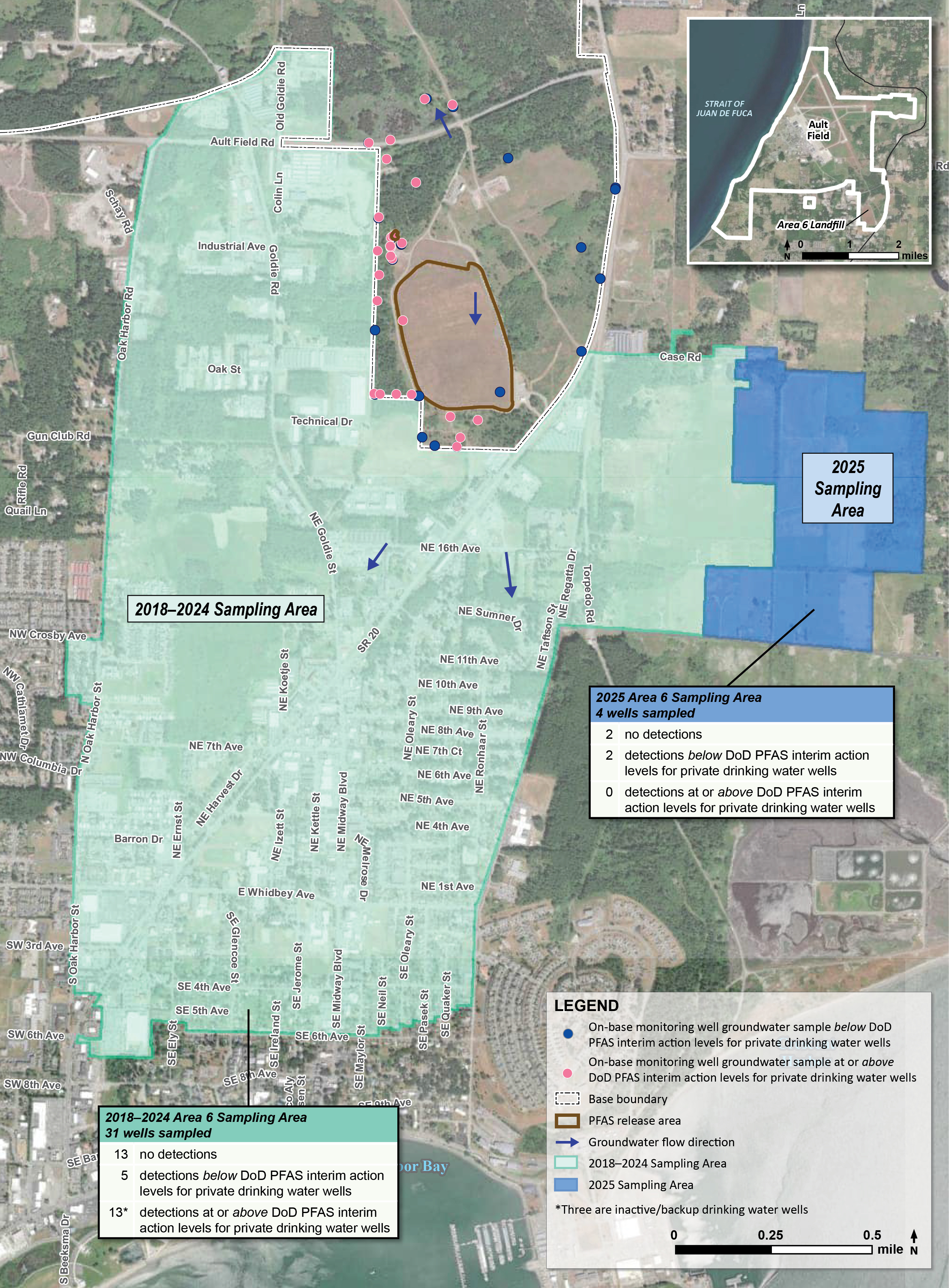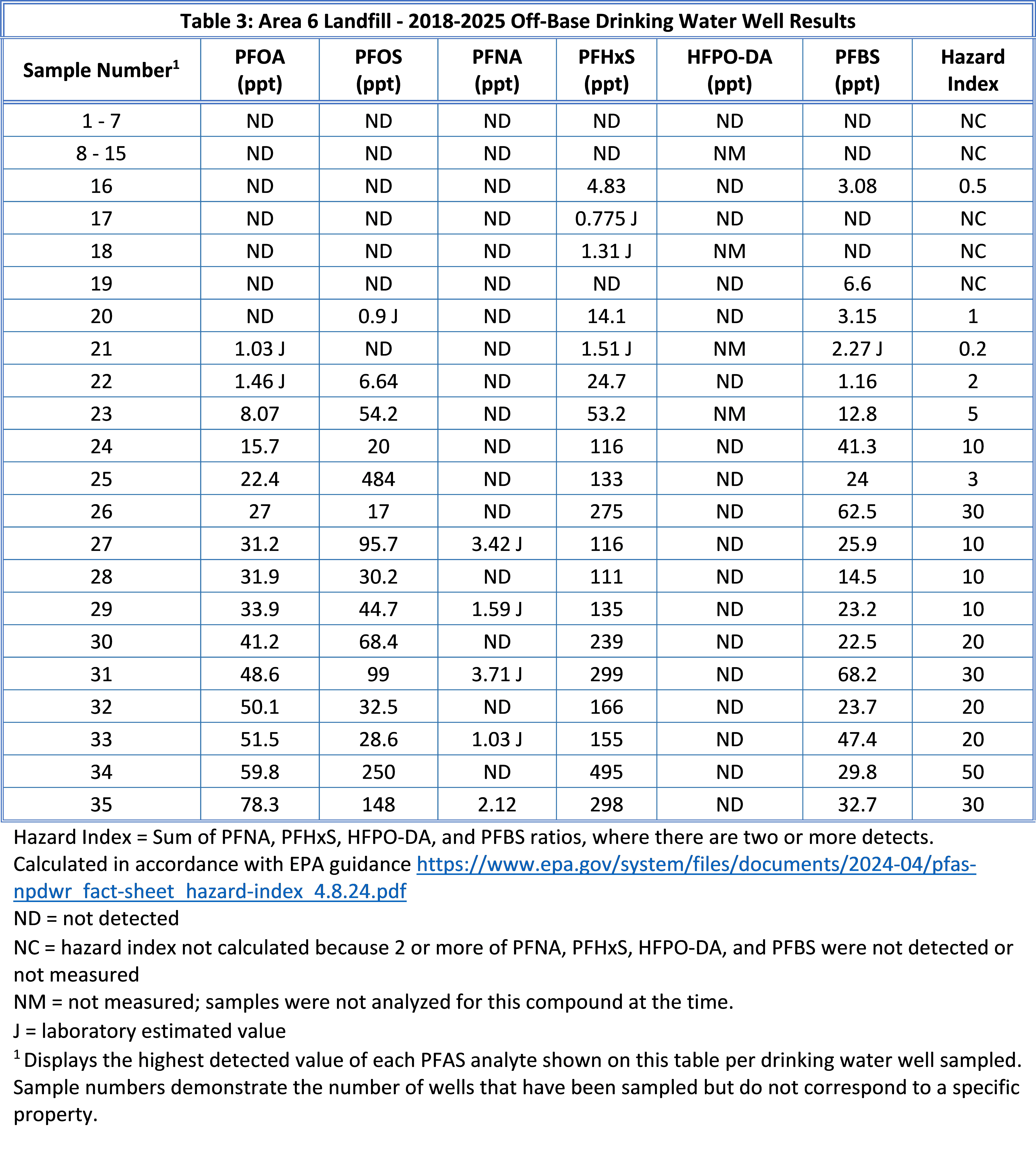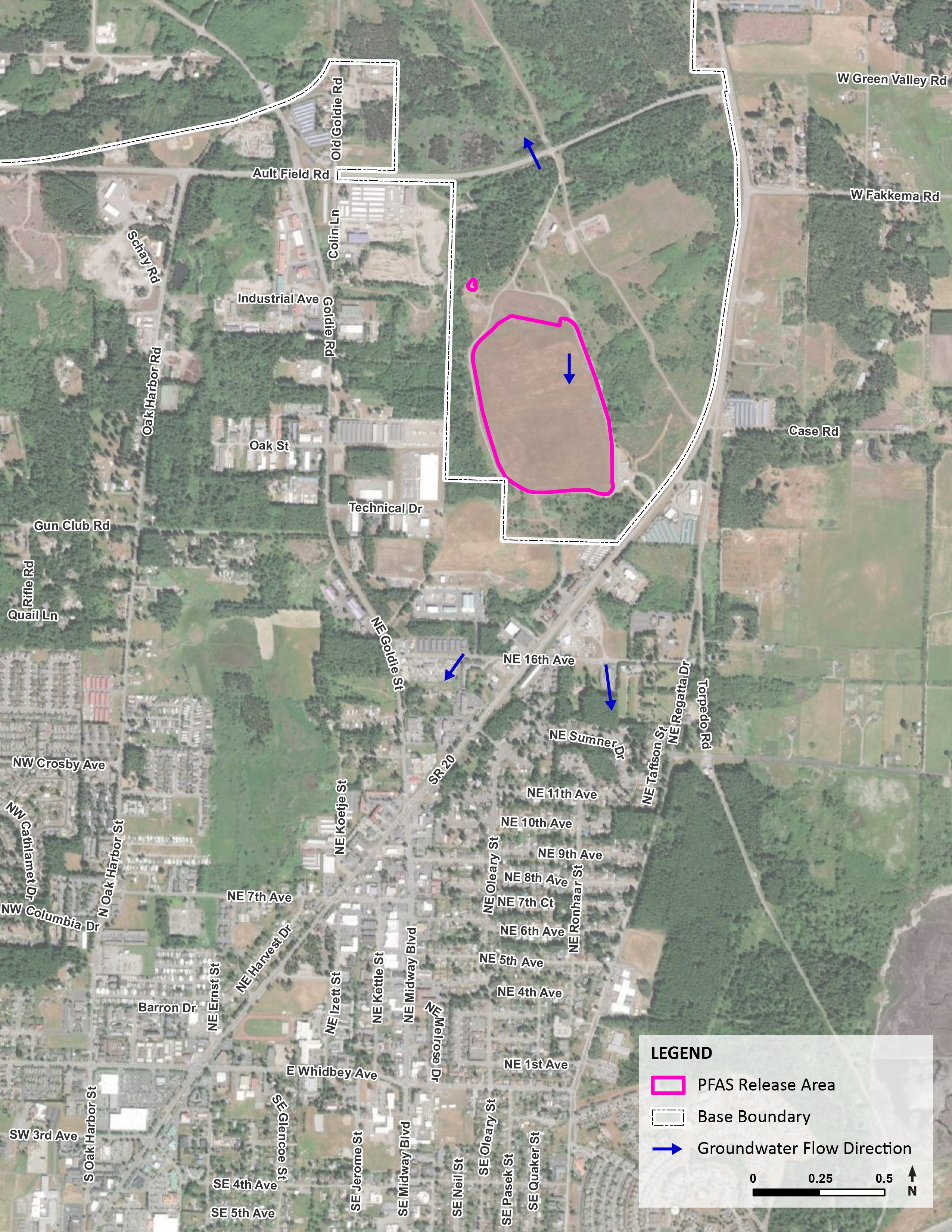The U.S. Navy is requesting permission to sample water obtained from drinking water wells located within the sampling areas near the Area 6 Landfill at Naval Air Station Whidbey Island to test for certain per- and polyfluoroalkyl substances, commonly known as PFAS.
Property owners with drinking water wells located in the sampling areas may request sampling by leaving a message at 1-844-WHI-PFAS (1-844-944-7327), or by sending an email to naswi.pfas@jacobs.com. Please include your name, property address, and phone number.
If your drinking water is provided by a public water provider in the sampling area, the Navy has already sampled or offered to sample their water and does not need to sample at your individual property.
Introduction
Per- and polyfluoroalkyl substances (PFAS) are a family of thousands of different chemicals which have been widely used in industrial and consumer products since the 1950s. PFAS are man-made and have been used in many household and industrial products because of their stain- and water-repellent properties. PFAS are now present virtually everywhere in the world. The Navy and Department of Defense (DoD) have developed policies to address past releases of PFAS at installations nationwide.
The most common activity that could have resulted in the historical release of PFAS to the environment at the Area 6 Landfill (Figure 1) is the disposal of PFAS-containing materials including firefighting foam (specifically, aqueous film-forming foam, or AFFF). Because of this historical use, PFAS are present in the groundwater at the Area 6 Landfill and have been detected in nearby off-base drinking water wells in the direction that the groundwater flows away the base.
On April 26, 2024, the U.S. Environmental Protection Agency (EPA) issued a final National Primary Drinking Water Regulation (NPDWR) establishing nationwide drinking water standards for certain PFAS under the Safe Drinking Water Act. The regulation applies to public drinking water systems. Operators of public drinking water systems regulated by the NPDWR have five years to meet these standards. In September 2024, DoD published “Prioritization of Department of Defense Cleanup Actions to Implement the Federal Drinking Water Standards for Per- and Polyfluoroalkyl Substances under the Defense Environmental Restoration Program,” which describes DoD’s plans to incorporate the EPA’s drinking water regulation into DoD’s ongoing PFAS cleanups and prioritize interim actions to address private drinking water wells with the highest levels of PFAS from DoD activities.
Table 1 presents the DoD PFAS interim action levels for private drinking water wells. The DoD’s September 2024 memorandum can be found here. To learn more about the DoD’s September 2024 memorandum, the November 19, 2024, DoD PFAS Outreach Event can be found here.

The Navy continues to follow the policy it issued in June 2016 to conduct investigations at installations where there has been a known or suspected release of PFAS to the environment. The policy can be found here.
Private Drinking Water Well Sampling Near the Area 6 Landfill
Certain PFAS have been detected in groundwater near the Area 6 Landfill above the DoD PFAS interim action levels for private drinking water wells (Figure 1). As a result, multiple sampling areas have been established in the direction that groundwater flows away from the locations of these detections. The Navy continues to offer sampling to all property owners whose property is within the sampling areas (Figure 1) and whose drinking water is supplied by a drinking water well.
Figure 1: Area 6 Landfill Sampling Areas

The Navy is requesting permission to sample certain drinking water wells located in the sampling areas shown on Figure 1. The Navy has also determined that certain drinking water wells sampled in February and August of 2018 should be resampled because the laboratory method at that time could not detect PFAS at the current lower levels. Because of the laboratory method limitations, PFAS previously reported as not detected may now be detectable at low levels in these drinking water wells. Records indicate the City of Oak Harbor water system provides drinking water to most of the properties within the sampling areas. If your drinking water is provided by City of Oak Harbor, the Navy does not need to sample your drinking water. Property owners and tenants should contact their public water system with questions regarding its treatment and testing of drinking water.
2018 - 2025 Off-Base Drinking Water Well Sampling Near the Area 6 Landfill
From 2018 through 2024, the Navy sampled 31 drinking water wells near the Area 6 Landfill based on information available about potential PFAS releases. PFOA and/or PFOS were detected in nine drinking water wells above 70 parts per trillion (ppt), the DoD interim action level at the time. In 2022, the Navy connected six properties to the City of Oak Harbor water system. The Navy will continue to provide bottled water for drinking and cooking or a kitchen sink filtration system to the remaining five properties served by three wells with detections of PFOA and/or PFOS above 70 ppt until an enduring solution can be implemented.
Since 2019, the Navy has monitored drinking water wells in the sampling areas. Twice per year, the Navy samples drinking water wells with prior PFAS detections and drinking water wells next to properties with PFOA and/or PFOS above 70 ppt, the DoD’s previous interim action level.
Drinking water well sampling was conducted again in early 2025, the sampling included some new wells and many resampled wells. During this sampling, there were no detections at or above the DoD PFAS interim action levels for private drinking water wells. To date, 35 wells have been sampled near Area 6 Landfill (Table 2) including the 31 wells that were sampled from 2018 through 2024. Table 3 presents the PFAS results.


Identification of PFAS Releases at Area 6 Landfill
A PFAS Preliminary Assessment (PA) was finalized in 2018 that identified 35 areas (including the Area 6 Landfill) where releases of PFAS may have occurred, and subsequently conducted a Site Inspection (SI), which was finalized in September 2020. Based on the SI results, a Remedial Investigation is underway to understand the releases better.
The PFAS release areas investigated at the Area 6 Landfill are depicted on Figure 2; Table 4 lists the release areas investigated during the SI and RI along with the current status. The Navy will continue on-base PFAS investigations following the CERCLA process and evaluate if additional actions are needed. All final documents are posted to the Navy’s CERCLA Administrative Record available at https://go.usa.gov/xh2Rd.
Figure 2: Area 6 Landfill PFAS Release Areas

